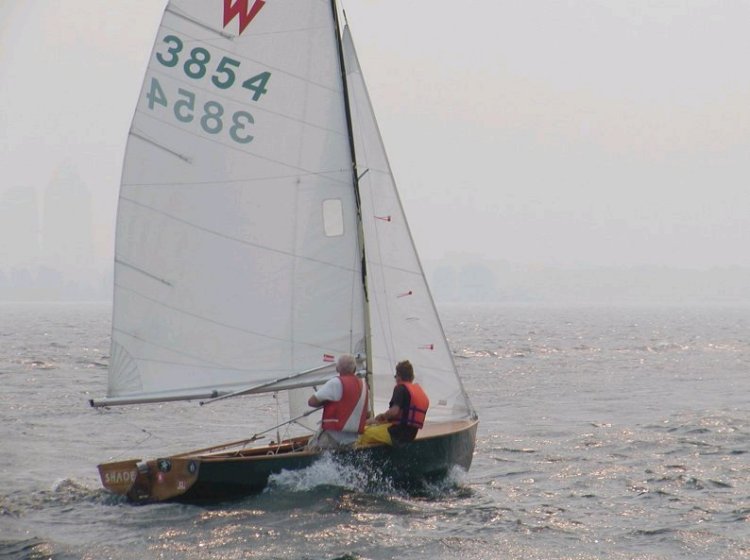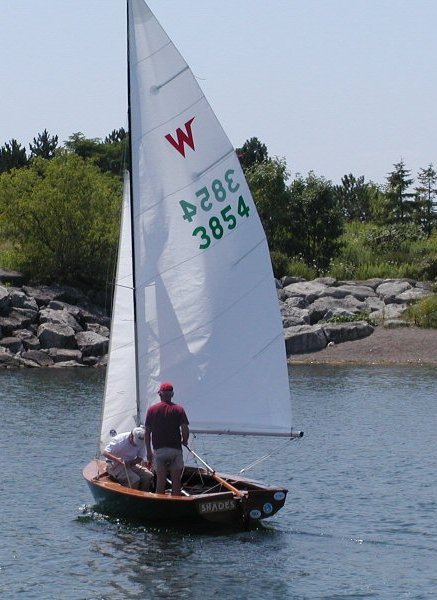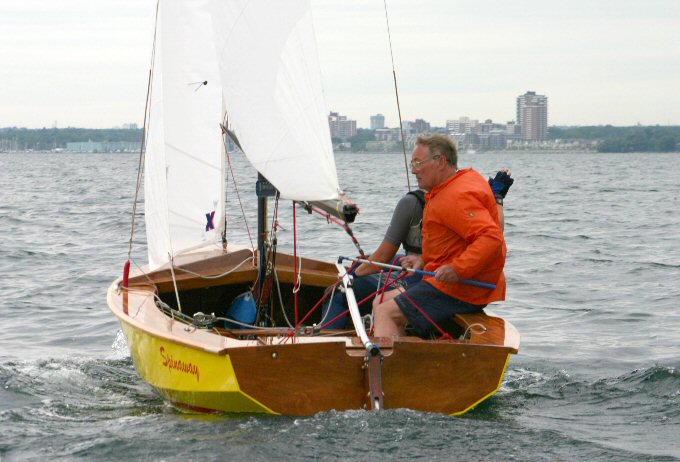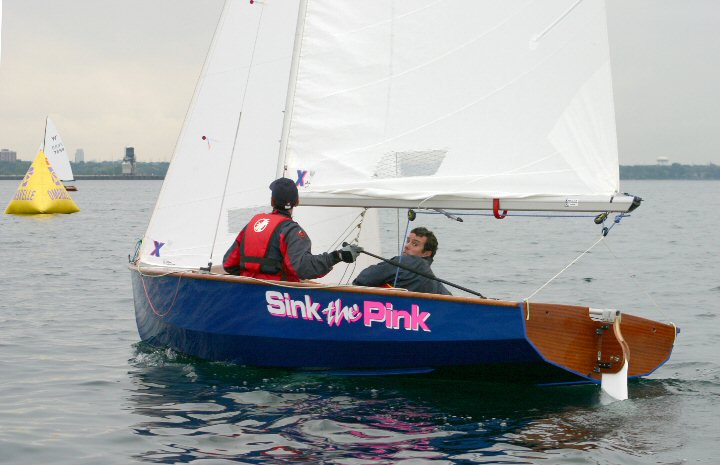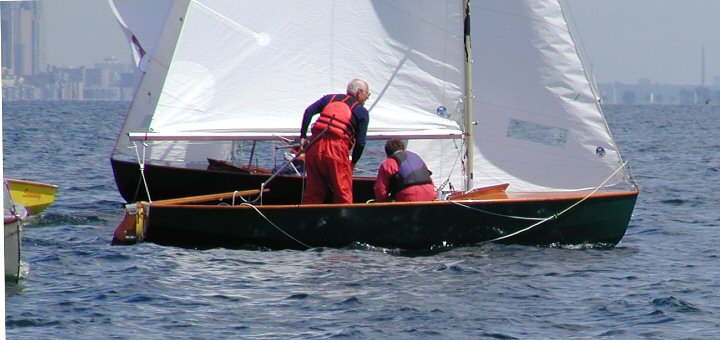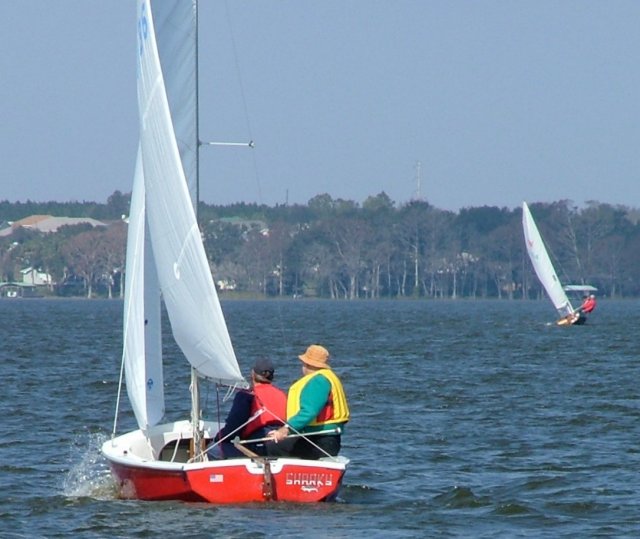Subject: a bridle shower for Mo
Metcalf? Midwinters racing leads to bridle and vang talk
Hi,
Morris:
I'll do
my best to answer (in green) below.
Uncle Al (W3854)
-----
Original Message -----
From:
Morris Metcalf
Sent:
Friday, February 18, 2005 1:11 PM
Subject:
... Bridle
Al,
... I am now using a fixed bridle and like the thinking
that goes with the adjustable bridle described in the Wayfarer
Institute bridle section.
Not so much that it is adjustable but rather the bridle won't center
the boom. I
really would advise sticking with the (fixed) bridle. Mike Mac won the
1992 Worlds with one. Remeber, the bridle does not force you to centre
the boom upwind, it just makes it easier to do so! With a decent amount
of vang tension applied, you just ease the main as required to keep the
boat fairly flat - see pic of my 90-pound son, Dave, and me below in
the 2002 Around-the-Island Race in Toronto where (to our very pleasant
surprise!) we caught and passed two good heavy-air teams that had much
more hiking weight
Note
how far out the boom is and how good vang tension keeps the boom from
rising. I have never forgotten this setting (and picture) since we went
amazingly well with it. Usually I let the boat heel too much - as most
people do!
Since I have a lot of experience with travelers, the
bridle is new to me.
The
traveller is really only useful if you want to ease your sheeting point
off to leeward. This kills pointing and is only
useful in survival conditions plus waves of serious height - five feet
or more - when pointing becomes a secondary consideration to keeping
the boat moving forward.
I like the non-adjusting bridle as it allows one to
concentrate on other things and I find that appealing.
Amen!!
I will be getting more vang tension with a revamped vang
which will increase the offset as the boom lowers as described in the
WI. I realize the centered boom is not always desirable and feel
there is a happy medium allowable with the bridle. What do you suggest
as the starting point for bridle length using a dimension
from the rear deck to the centerline of the block in the bridle.
I have
never made an exact measurement since this will vary from boat to boat,
depending on rake and mainsail cut and size and type
of boom and bridle block (we use Harken 082 bullet blocks: one at
the boom end and one on the bride - see http://www.wayfarerinternational.com/mainsheet.html but
most people (needlessly) use bulkier blocks, and mainsheets that are
needlessly fat. The starting point I have suggested is that the block
on the bridle should be able to come no higher than half-way to the
boom when the main is hoisted and there is no down pull on the
mainsheet. In essence, I want the bridle to be low enough that I can
"oversheet" the main (i.e. make the upper leech ticker stall) in medium
air conditions up to the wind strength when my crew and I can sit to
windward but not on the deck yet. With that set-up, we can now sheet
block-to-block as soon as we both start having to sit up on the deck,
knowing that we have lots of main leech tension (which equals lots of
pointing ability) but not too much - see photo from Midwinters
below.
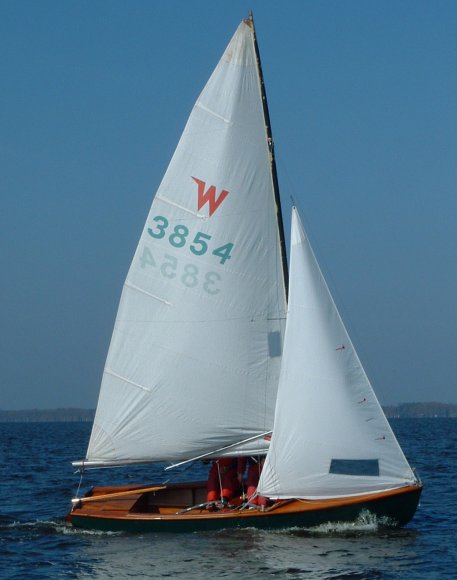
The key
is not to have the bridle too long, i.e. if in doubt, shorten it. We
sail mostly in relatively light airs and a bridle that is too long will
kill your pointing because it either keeps you from using all the leech
tension your mainsail can tolerate in the medium breezes mentioned
above (and pointing ability is directly proportional to main leech
tension!!!), or you will have to vang to get the desired
leech tension. But that will (a) depower your main needlessly, and (b)
keep you from centering the boom (also a key pointing ingredient!). In
the really light stuff, I have found that the short bridle doesn't seem
to cost me anything even though my boom ends up off centre (off the
corner off the transom in the real drifters) - see pic from Worlds
below.
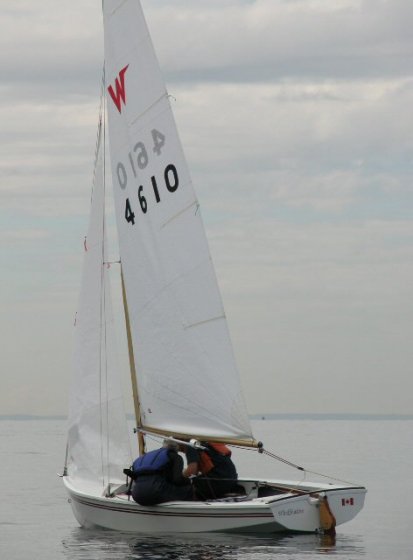
I think
this is because when it gets really light, sheeting the boom off centre
a bit, lets the sail produce a greater % of forward force, something
the centreboard appreciates since it does not function at peak
efficiency in the really slow going.
I'm
having trouble finding a really good pic of bidle length but have added
a few shots below that should help you get the picture:
Marc
and I going out for the practice race at the Worlds - bridle block no
more than halfway up towards boom end.
The
3rd-place boat from this past Worlds - note bridle ends further inboard
which does not matter since the key is how high off the deck you get
the bridle block.
The
fast Irish guys at the Worlds (10th?). This shows the boom-end
arrangement nicely. Their bridle block is higher than I would want it -
and we outpointed them in the light-to-medium stuff.
This
shows our bridle block height pretty well. We are just completing a
tack and I have begun to sheet in, hence the boom has started to move
closer to the bridle block. On this tack, we proceeded to pinch off the
Brits who placed 2-3 in the Worlds even though we were all getting a
persistent lift and they were inside us (to windward) and should have
killed us. Again, if in doubt make the bridle too short to start with -
leave some loose rope hanging in case you want to try it longer. My own
view is that the bridle block does not want to be much more than 12"
off the back deck? I guess one could measure my distance here by
printing this pic, measuring the height off the deck and comparing it
to the 15' 10" hull length?
Before I jump to a conclusion and return to the
traveler system I would like to try a more correct bridle and
vang combination. I realize there is a lot more going on with the
vang traveler combination than I can describe here. I guess I am
looking for a better starting point to work from with regards to bridle
length than what I have now.
Gosh I hope this makes sense.
It does
- and I hope the answer helps you. I think I may post this in the Weekly
Whiffle for Monday.
Morris Metcalf
W10245
-----
Original Message -----
Sent:
Sunday, February 20, 2005 2:42 PM
Subject:
bridle revisited
Hi, Morris:
Thought of you and your bridle as I was doing captions for
the second page of race 2 of the Midwinters just now. Look at the pic
below which illustrates perfectly the problem of a bridle that is too
long!! I will add parts of my intended caption below the pic.
Meanwhile, Jim
and Mike have rounded onto their beat but will not point with the best
as long as their main leech falls off to leeward like this. Since they
are sheeted in almost block to block, Jim should shorten his bridle to
give himself the ability to put more downpull on his leech without
having to resort to the vang.
Best regards,
Uncle Al (W3854)
Hi,
Morris:
Thanks
for the reference to the Mike Mac article which I will work into not
only the bridle appendix that will result from this exchange of ideas
with you, but also as another source of tuning basics that I will add
as a link (somewhere!) in the WIT.
With all due respect, I must beg to differ with Mike Mac on this one,
and I am copying Mike to get his views - if he has the time - I'll also
forward to Mike, the last email where we began the bridle talk. More in
green below. Best regards,
Uncle Al (W3854)
PS: I am
rearranging your letter somewhat by moving the Mike Mac quote nearer
the beginning to make your thinking easier to follow when I post it in
the Weekly Whiffle and the WIT. Hope you don't mind.
-----
Original Message -----
Sent:
Sunday, February 20, 2005 4:27 PM
Subject:
bridle revisited
Al,
Mike McNamera wrote the following
article in July 2001. http://www.yachtsandyachting.com/default2.asp?section=73&ArticleNumber=17
It took me awhile to relocate this part of it:
"The trend
in recent years has been to bring the boom right in to the centerline.
It is impossible to do this without overloading the leech with the
conventional track and so a variety of strop systems have been
developed. The most simple is a straightforward triangle of rope with a
block for the 2:1 purchase at its apex. The height of this block above
the transom is critical. The ideal height can be found by dropping the
block over the transom and then fastening the bridle ends on each
quarter so that the bearing surface of the block is level with the
bottom of the keel."
This is how I set Murphy's
Law up. Having sailed with it this way, I can actually
see what is really happening in your reference picture as well as
pictures of my own boat. Taking it one step farther, I think I have an
idea why this may not work for me.
One: Mike is wrong,
which is unlikely. Wrong
is perhaps too strong a word, but I think Mike fails to take into
account the variations in mast bend and mainsail size not to mention
block size, that, in my opinion, make it unwise to try to give people
an "ideal height" or an exact one for all occasions. Mike's suggested
"ideal height" may be a good starting point, but in the end, there is -
certainly among North American Wayfarers - far more diversity in
how far from deck level the boom hangs (with the main raised but not
wind-filled or sheeted down at all) than can be properly catered
to by one magic number. I stand by my recommendation that you need to
make sure that the bridle on your boat is short enough that you can
oversheet the main in the medium wind ranges where both crew members
are sitting to windward but not yet on the deck, say. Not that you
(usually) want to oversheet in those conditions, but you want to have
the ability to do so for two reasons:
1. judicious oversheeting upwind (such
that the upper leech ticker disappears for considerable stretches of
time behind the leech) can really help your pointing once your speed is
really good and the waves are not too bad. Of course when you do this,
you have to be really sensitive to any drop in boat speed - when
in doubt, let it out!
2. you want to have the ability to
sheet in a bit further for that small but fairly frequent window where
you and the crew are both on the deck, likely hiking out, but still
able to hold the boat down without resorting to the vang to flatten the
main.
On our boat, we can virtually always afford
to sheet block to block as soon as we are both sitting on the windward
deck to keep the boat flat, by which time it appears to become
virtually impossible to make the leech tickers indicate
a stall. My guideline would be: in these conditions, the main
should take a serious effort (which translates into more leech tension
which leads to better pointing!) to get sheeted block to block.
If it happens too easily, try shortening the bridle some more until you
do have to make a real effort to get block to block! This is definitely
not a case of "When in doubt, let it
out!" From what I have seen of the English boats, they tend to
have longer bridles, but I think we can point better over a greater
variety of medium air conditions that most of them.
The other is I have a Mark III
which has a very large deck hull overhang. This is I would guess about
an inch or so on the transom. By letting the bridle hang over this edge
to the po sition he indicates would add a couple of inches to the
length of the bridle in its normal sailing position. This overhang is
absent on I believe all the older models. In my mind this confirms the
bridle length is too long and gives me an indicator as to how much to
shorten it before the next trial. Sounds like a reasonable explanation, but
what I think you should do is go out in medium winds with easily
adjustable knots in your bridle and and adjust to my rough guidelines
above. Start out with your bridle with say, 3-4" less clearance than it
has now, try sheeting in block to block as you sail closehauled. If
it's still too easy to reach the block-to-block position, shorten it
some more. Repeat until you have to do serious pulling on the mainsheet
to reach block-to-block status.
This a great explanation. It
probably can be applied to all the European and US boats with maybe an
exceptions being the Mark III and possibly the worlds. The
overhang would make a difference. A bridle a couple of inches
shorter I would believe would be about right in my case. It would
appear Murphy's Law has been applied again.
Sorry to beat a dead horse with
this, but I find this to be very interesting. Thanks for your time and
comments. I'm
enjoying having to explain and justify our approach, too.
It has been very much appreciated
and I think between this and a vang fix ( retaining lever and going to
triple block rather than single) I can see a much brighter future. Now
I just need to get Andrew out in the boat for some spinnaker practice. And don't forget to
fiddle with your bridle! Andrew sounds keen and looks like he would be
a good crew to have when it starts to get breezy and the sailing gets
tough.
Thanks again.
Mo (W10245) for
the record
-----
Original Message -----
Sent:
Monday, February 21, 2005 12:45 AM
Subject:
bridle
Hi, Mike:
Background
for the other email - in case you can find the time and the
inclination. Hope all is well with you. Best regards,
Uncle Al (W3854)
PS: We
used the old red chute you gave me in 1992 for this year's Midwinters
and it performed very nicely.
... and a
response from Mike McNamara, busy as he is:
-----
Original Message -----
Sent:
Monday, February 21, 2005 2:59 AM
Subject:
bridle revisited
Thanks Al. I have no
problem with changing "ideal" to "a good starting position". In fact it
would be good idea to do so, because I do shorten it so that the block
is level with my bottom rudder fitting on the transom in a breeze.
As you know I am constantly
wary that I don`t oversheet the leech and if there is a plus to having
a fixed bridle position, it is that, as the kicker (vang) is loaded to
keep the whole luff length of the main backing at the same time,
the aft boom end will go out.......as the boom drops down.
Best wishes,
Michael.
|
